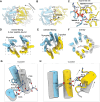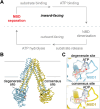This is a preprint.
Nucleotide-dependent conformational changes direct peptide export by the transporter associated with antigen processing
- PMID: 40666987
- PMCID: PMC12262423
- DOI: 10.1101/2025.06.12.659373
Nucleotide-dependent conformational changes direct peptide export by the transporter associated with antigen processing
Abstract
The transporter associated with antigen processing (TAP) is essential for adaptive immunity, delivering peptide antigens from the cytoplasm into the endoplasmic reticulum (ER) for loading onto MHC-I molecules. Previous studies have revealed the mechanism by which TAP selectively binds peptides while allowing for sequence diversity, but how the bound peptides are transported and released into the ER is not yet fully understood. Here, we report cryo-electron microscopy structures of human TAP in multiple functional states along the transport cycle. In the inward-facing conformation, ATP binding strengthens intradomain assembly. The transition to the outward-facing conformation is highly temperature-dependent and leads to a complete reconfiguration of the peptide-binding site, facilitating peptide release. ATP hydrolysis opens the consensus site, and the subsequent separation of the NBDs resets the transport cycle. These findings establish a comprehensive structural framework for understanding the mechanisms of peptide transport, vanadate trapping, and trans-inhibition.
Keywords: ABC transporter; MHC-I; adaptive immunity; antigen presentation; nucleotide binding domain; transporter associated with antigen processing.
Conflict of interest statement
Declaration of interests The authors declare no competing interests.
Figures





Similar articles
-
Nucleotide-dependent conformational changes direct peptide export by the transporter associated with antigen processing.Immunity. 2025 Aug 23:S1074-7613(25)00366-8. doi: 10.1016/j.immuni.2025.08.003. Online ahead of print. Immunity. 2025. PMID: 40885191
-
Alternate MHC I Antigen Presentation Pathways Allow CD8+ T-cell Recognition and Killing of Cancer Cells in the Absence of β2M or TAP.Cancer Immunol Res. 2025 Jan 9;13(1):98-108. doi: 10.1158/2326-6066.CIR-24-0320. Cancer Immunol Res. 2025. PMID: 39485834 Free PMC article.
-
Molecular insights into ATP-mediated NBD dimerization in an ABC transporter.Comput Biol Chem. 2025 Dec;119:108600. doi: 10.1016/j.compbiolchem.2025.108600. Epub 2025 Jul 18. Comput Biol Chem. 2025. PMID: 40716294
-
The Black Book of Psychotropic Dosing and Monitoring.Psychopharmacol Bull. 2024 Jul 8;54(3):8-59. Psychopharmacol Bull. 2024. PMID: 38993656 Free PMC article. Review.
-
Management of urinary stones by experts in stone disease (ESD 2025).Arch Ital Urol Androl. 2025 Jun 30;97(2):14085. doi: 10.4081/aiua.2025.14085. Epub 2025 Jun 30. Arch Ital Urol Androl. 2025. PMID: 40583613 Review.
References
-
- Pishesha N., Harmand T. J. & Ploegh H. L. A guide to antigen processing and presentation. Nat Rev Immunol 22, 751–764 (2022). - PubMed
-
- Spies T. et al. Presentation of viral antigen by MHC class I molecules is dependent on a putative peptide transporter heterodimer. Nature 355, 644–646 (1992). - PubMed
-
- Kelly A. et al. Assembly and function of the two ABC transporter proteins encoded in the human major histocompatibility complex. Nature 355, 641–644 (1992). - PubMed
Publication types
Grants and funding
LinkOut - more resources
Full Text Sources
Research Materials
Miscellaneous
